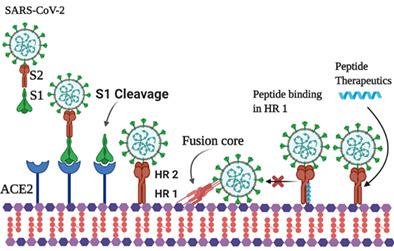当前位置:
X-MOL 学术
›
J. Comput. Chem.
›
论文详情
Our official English website, www.x-mol.net, welcomes your
feedback! (Note: you will need to create a separate account there.)
Repurposing fusion inhibitor peptide against SARS-CoV-2
Journal of Computational Chemistry ( IF 3.4 ) Pub Date : 2021-09-30 , DOI: 10.1002/jcc.26758 Faiyaz Md Efaz 1 , Shafiqul Islam 1 , Shafi Ahmad Talukder 1 , Shaila Akter 1 , Md Zakaria Tashrif 1 , Md Ackas Ali 1 , Md Abu Sufian 2 , Md Rimon Parves 1 , Md Jahirul Islam 1 , Mohammad A Halim 3, 4
Journal of Computational Chemistry ( IF 3.4 ) Pub Date : 2021-09-30 , DOI: 10.1002/jcc.26758 Faiyaz Md Efaz 1 , Shafiqul Islam 1 , Shafi Ahmad Talukder 1 , Shaila Akter 1 , Md Zakaria Tashrif 1 , Md Ackas Ali 1 , Md Abu Sufian 2 , Md Rimon Parves 1 , Md Jahirul Islam 1 , Mohammad A Halim 3, 4
Affiliation

|
Severe acute respiratory syndrome coronavirus 2 (SARS-CoV-2) is continuously evolving. Although several vaccines were approved, this pandemic is still a major threat to public life. Till date, no established therapies are available against SARS-CoV-2. Peptide inhibitors hold great promise for this viral pathogen due to their efficacy, safety, and specificity. In this study, seventeen antiviral peptides which were known to inhibit SARS-CoV-1 are collected and computationally screened against heptad repeat 1 (HR1) of the SARS-CoV-2 spike protein (S2). Out of 17 peptides, Fp13 and Fp14 showed better binding affinity toward HR1 compared to a control peptide EK1 (a modified pan-coronavirus fusion inhibitor) in molecular docking. To explore the time-dependent interactions of the fusion peptide with HR1, molecular dynamics simulation was performed incorporating lipid membrane. During 100 ns MD simulation, structural and energy parameters of Fp13-HR1 and Fp14-HR1 complexes demonstrated lower fluctuations compared to the control EK1-HR1 complex. Furthermore, principal component analysis and free energy landscape study revealed that these two peptides (Fp13 and Fp14) strongly bind to the HR1 with higher affinity than that of control EK1. Tyr917, Asn919, Gln926, lys933, and Gln949 residues in HR1 protein were found to be crucial residues for peptide interaction. Notably, Fp13, Fp14 showed reasonably better binding free energy and hydrogen bond contribution than that of EK1. Taken together, Fp13 and Fp14 peptides may be highly specific for HR1 which can potentially prevent the formation of the fusion core and could be further developed as therapeutics for treatment or prophylaxis of SARS-CoV-2 infection.
中文翻译:

重新利用针对 SARS-CoV-2 的融合抑制肽
严重急性呼吸系统综合症冠状病毒 2 (SARS-CoV-2) 正在不断演变。尽管批准了几种疫苗,但这种大流行仍然是对公共生活的主要威胁。迄今为止,还没有针对 SARS-CoV-2 的既定疗法。由于其有效性、安全性和特异性,肽抑制剂对这种病毒病原体具有很大的希望。在这项研究中,收集了 17 种已知可抑制 SARS-CoV-1 的抗病毒肽,并针对 SARS-CoV-2 刺突蛋白 (S2) 的七肽重复序列 1 (HR1) 进行了计算筛选。在分子对接中,与对照肽 EK1(一种改良的泛冠状病毒融合抑制剂)相比,在 17 种肽中,Fp13 和 Fp14 对 HR1 显示出更好的结合亲和力。为了探索融合肽与 HR1 的时间依赖性相互作用,结合脂质膜进行分子动力学模拟。在 100 ns MD 模拟中,与对照 EK1-HR1 复合物相比,Fp13-HR1 和 Fp14-HR1 复合物的结构和能量参数表现出较低的波动。此外,主成分分析和自由能景观研究表明,这两种肽(Fp13 和 Fp14)以比对照 EK1 更高的亲和力与 HR1 强结合。发现 HR1 蛋白中的 Tyr917、Asn919、Gln926、lys933 和 Gln949 残基是肽相互作用的关键残基。值得注意的是,Fp13、Fp14 显示出比 EK1 更好的结合自由能和氢键贡献。综合起来,
更新日期:2021-11-15
中文翻译:

重新利用针对 SARS-CoV-2 的融合抑制肽
严重急性呼吸系统综合症冠状病毒 2 (SARS-CoV-2) 正在不断演变。尽管批准了几种疫苗,但这种大流行仍然是对公共生活的主要威胁。迄今为止,还没有针对 SARS-CoV-2 的既定疗法。由于其有效性、安全性和特异性,肽抑制剂对这种病毒病原体具有很大的希望。在这项研究中,收集了 17 种已知可抑制 SARS-CoV-1 的抗病毒肽,并针对 SARS-CoV-2 刺突蛋白 (S2) 的七肽重复序列 1 (HR1) 进行了计算筛选。在分子对接中,与对照肽 EK1(一种改良的泛冠状病毒融合抑制剂)相比,在 17 种肽中,Fp13 和 Fp14 对 HR1 显示出更好的结合亲和力。为了探索融合肽与 HR1 的时间依赖性相互作用,结合脂质膜进行分子动力学模拟。在 100 ns MD 模拟中,与对照 EK1-HR1 复合物相比,Fp13-HR1 和 Fp14-HR1 复合物的结构和能量参数表现出较低的波动。此外,主成分分析和自由能景观研究表明,这两种肽(Fp13 和 Fp14)以比对照 EK1 更高的亲和力与 HR1 强结合。发现 HR1 蛋白中的 Tyr917、Asn919、Gln926、lys933 和 Gln949 残基是肽相互作用的关键残基。值得注意的是,Fp13、Fp14 显示出比 EK1 更好的结合自由能和氢键贡献。综合起来,











































 京公网安备 11010802027423号
京公网安备 11010802027423号